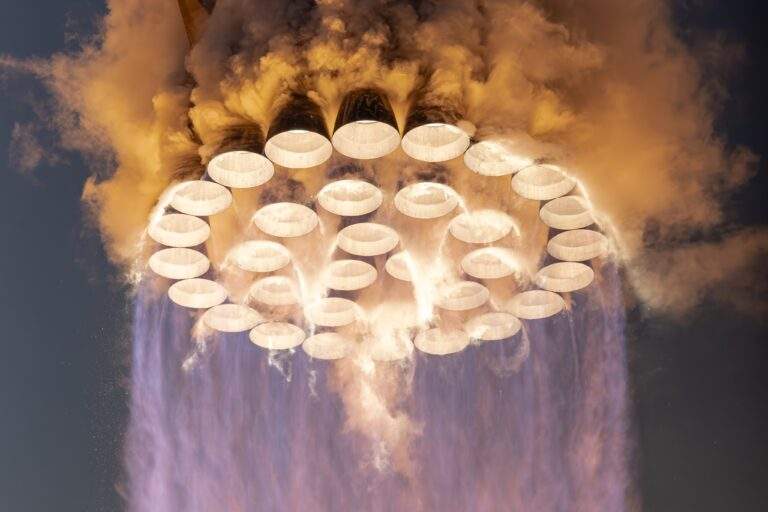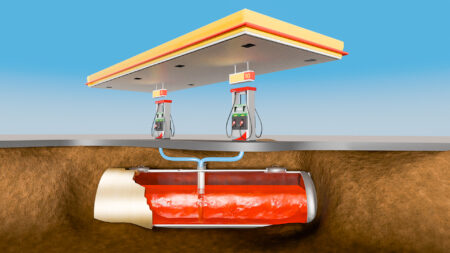SpaceX’s Starship rocket is currently awaiting final regulatory approval before the vehicle’s 2nd flight test can take place. Launch of the world’s most powerful rocket is set to lift-off no earlier than late October.
Test Flight 1
On April 20, Starship Super Heavy lifted off on its maiden voyage proving to be a spectacular sight both during flight and upon its explosion.
The vehicle reached an altitude of 39km just prior to the Autonomous Flight Safety System (AFSS) issuing the destruct command.
Whilst there were numerous issues that cropped up during flight, the predominant issue was fires coming from the vehicle’s booster due to leaking propellant. This ultimately led to the vehicle’s failure.

Full Stack Returns
Last week, the Booster 9, Ship 25 full stack returned proving the vehicle is almost ready for launch from a technical standpoint. Destacking of Booster 9 and Ship 25, bar no unexpected issues, will only occur once more. This will be to arm the AFSS prior to flight in case of an anomaly during launch.
Over the next few weeks, SpaceX will continue to prepare for Starship’s 2nd flight test awaiting news from the Federal Aviation Administration (FAA) for the go ahead for launch.
Booster 9 and Ship 25 Upgrades
SpaceX have implemented a number of upgrades on both the booster and the ship as well as significant pad upgrades following Starship’s 1st test flight.
Key upgrades include an electric thrust vector control system for the Booster’s Raptors, a new hot staging system, and a flame deflector at the pad.
Due to Raptor improvements, Booster 9’s 33 engines host an electric thrust vector control (TVC) system. This replaces the previous hydraulic system which was less energy efficient and had more points of failure. In addition, it removes the need for hydraulic power units (HPUs) on the booster, reducing the vehicle’s weight. The upgrade should therefore not only improve Raptor reliability but vehicle performance.
The flight 2 booster also has new leak mitigations in place after the significant fires during flight 1. Booster 9 sports updated methane turbopumps with new seals. The change was made in order to reduce methane leakage and so the risk of fires.
Due to issues with the Autonomous Flight Safety System (AFSS) during flight 1, the AFSS has also been updated with an extra explosive charge. This will help ensure the vehicle will respond to a destruct command with immediate effect.

Perhaps the most noticeable change ahead of Starship’s next flight test is the introduction of a hot staging system. SpaceX teams have designed and then installed a hot stage ring on top of Booster 9 to enable the hot staging manoeuvre. Hot staging is the process where the 2nd stage engines ignite to push the 2nd stage away from the 1st stage. This allows the Ship to always be under acceleration. Increased acceleration results in increased performance explaining why SpaceX has made the change.
Ship 25 also hosts several new upgrades. The vehicle now contains 6 Raptor 2 engines which brings greater efficiency and reliability. On the Ship, there is an extra charge on its common dome to improve the reliability of the AFSS. Like with the Booster, this will help ensure the vehicle explodes on command.
Additionally, Ship 25 has thicker engine shielding. This will be important during hot staging in particular.

Orbital Launch Site Upgrades
The power of 33 Raptor engines left behind a path of destruction after Starship’s maiden test flight. Due to there being no flame deflector, a significant crater was left under the orbital launch mount. As well as that, chunks of concrete were discovered hundreds of metres away from the launch pad.
Due to the dramatic scenes of flying concrete and huge craters, SpaceX quickly developed a flame deflector system to mitigate against those issues. The introduction of a flame deflector will reduce damage to the pad, to the rocket, and to the ground systems so diminishing the need for pad repairs after each flight.
In addition, the pad has been heavily reinforced with concrete following the heavy damage from flight 1.

FAA
Following Starship’s anomaly during flight test 1, the FAA launched a mishap investigation into the launch. After a thorough investigation, the government agency released their findings on September 8 outlining 63 corrective actions SpaceX must take ahead of Starship’s 2nd flight test. Though the statement was released just a few weeks ago, it is likely the FAA told SpaceX of some of these corrective actions long before the closure of the mishap investigation.
We have closed the @SpaceX Super Heavy mishap investigation. The final report cites multiple root causes of the April 20 mishap and 63 corrective actions SpaceX must take. This does not signal resumption of Starship launches at Boca Chica. Full statement: https://t.co/8JHHZ2vwcF.
— The FAA ?? (@FAANews) September 8, 2023
Some of the key corrective actions mentioned included a pad redesign, an improved AFSS, and a vehicle redesign to prevent fires and leaks. SpaceX has spent significant time on meeting these corrections and the company’s CEO and chief engineer Elon Musk said all corrective actions had been completed on September 10.
Though the mishap investigation is now complete, the FAA must still complete a safety review before Starship’s second flight test. Per the head of the FAA’s commercial space transportation office, this review is expected to be completed by the end of the October. This is a key milestone which will give the go ahead for Starship’s next launch.
Testing and Production Elsewhere
Whilst Booster 9 and Ship 25 await its launch, SpaceX is busy testing new prototypes ahead of future flights. Ship 29 and Booster 10 have recently undergone cryogenic proof testing which appears to have been largely successful. Engine installation is up next for both prototypes.
From proof testing to ship stacking where Ship 31 has gained its mid LOX rings in the past week. Ship 31 adds to the numerous Ship prototypes currently in production. As Ship 25 and 26 remain at the launch site, Ships 28, 29, 30 and 31 are in testing or in the late stages of production.
On top of Ship 29 testing, Ship 24.2 is also now at Masseys to undertake testing in the near future.
Test Tank 24.2 is the latest to make a pilgrimage to SpaceX Masseys.https://t.co/e3xbqPnwZ5 pic.twitter.com/4pMZwdVUsP
— Chris Bergin – NSF (@NASASpaceflight) September 29, 2023












